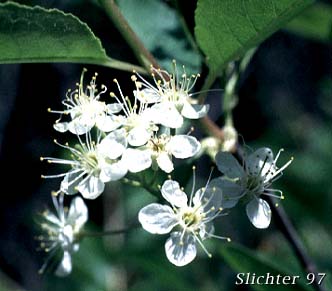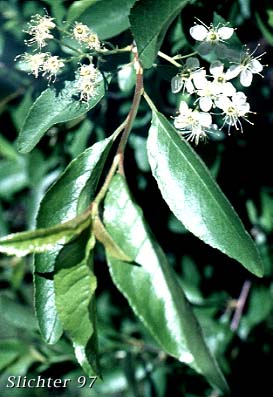

 Photo at right is of a bitter cherry (variety emarginata) located
between Hood River and Mosier, OR along the Old Gorge Highway......May, 1995.
Photo at right is of a bitter cherry (variety emarginata) located
between Hood River and Mosier, OR along the Old Gorge Highway......May, 1995.
Bitter cherry is a shrub or small tree to 15 meters in height and with trunks to 30 cm in diameter. The bark of older trunks and branches peels horizontally, while that of younger twigs is smooth, reddish-brown, and somewhat shiny with scattered grayish red areas. The twigs are round in cross-section and 2 mm or greater in diameter.
The leaves are oval in shape and from 2.5-8 cm long. They are alternate on the stems, and have a pair of knob-like glands at the base. The upper surface of the leaf is smooth while the underside may be somewhat hairy. The margins are serrate.
The flowers are in clumps of 5-8, with 5 white petals, 5 smaller and green sepals, and as many as 20 stamens. The fruits are small, 1 cm in diameter, and bright red to black in color.
variety emarginata: The variety found in the Cascades and on the plains to their east. It is also found in the Olympic Mts.. It is more shrub-like in its growth, usually ranging from 1-4 meters in height. The leaves are variable, ranging from smooth to fairly heavily haired. The petals may also be haired on the back (outer) surfaces.
variety mollis: The variety of bitter cherry found in the lowlands and foothills to the west of the Cascades. It is more treelike in its growth, growing at most as much as 15 meter tall. The trunk is up to 30 cm thick. The lower leaf surfaces and the calyx are especially heavily haired.
The fruits may be eaten although their taste is bitter. They are best used with lots of sugar in jams. The bark has been used for weaving decorative baskets. The fruits are an important food source for many species of birds. The flowers are an important nectar source for humming birds, honeybees, and other pollinators early in the spring. Downed trees become an important habitat for insects, amphibians, and small mammals as the bark is very resistant to decay. The result is that the bark persists while the internal wood decays and provides housing space for these wee beasties!
Bitter cherry may be bound in moist, disturbed areas, especially open sandy or gravelly areas and along stream banks. It tends to be shade-intolerant. In the Pacific Northwest, it may be found from sea level to about 1300 meters in elevation.
Bitter cherry may be found from southern British Columbia (including Vancouver Island) south through Washington and Oregon to the Sierra Nevada of California. It may be found eastward to the Rocky Mountains.
Variety mollis is found mainly west of the Cascades from southern British Columbia south to southern Oregon. Variety emarginata is found in and east of the Cascades from south central British Columbia south to California and also found in the Olympic Mts. of Washington.